Is Your Business Ready for OKRs? Here Are the Top 10 Indicators
Objective and Key Results (OKRs) have emerged as a
Objective and Key Results (OKRs) have emerged as a transformative framework in the modern business. With the ever-increasing need for OKR in diverse sectors, from tech giants to nimble startups, the benefits of this goal-setting methodology have become undeniably profound. Rooted in creating alignment, driving focus, and ensuring measurable outcomes, OKRs respond to the need for Strategic Planning for business and the need for OKR in business at large.
But how does one conclude if their company stands where OKRs are not just beneficial, but essential? Today, we'll delve into the top signs that spotlight this very need. But, Before that let us have a short brush-up of OKRs.
Strategic planning for Business gives direction. It starts with a clear vision and purpose. Set long-term goals that match your mission. Know your market and your competitors. Analyze what you do well and where you fall short. Bring your leadership team into the process. Break big goals into smaller, actionable steps. Assign ownership. Set timelines. Use data to track progress. Review the plan regularly. Make quick changes when needed. Keep everyone aligned and informed. Focus on outcomes, not just activities. Strategic planning isn’t a one-time event. It’s a continuous cycle of thinking, acting, and improving.
OKR stands for Objective and Key Results. It is a goal-setting framework that helps organizations do strategic planning for business by defining and tracking objectives and their outcomes. The methodology is widely credited to Andy Grove of Intel and was popularized by companies like Google due to its effectiveness in setting clear and measurable goals.
Here's a basic breakdown
Objective: This is a clear, qualitative description of what you want to achieve. Objectives should be short, inspirational, and engaging. They set a clear direction and represent the broader goal.
Key Results: These are specific, quantitative metrics that measure the achievement of the objective. They should be measurable, time-bound, and limited in number (usually 3 to 5 KRs per objective).
A simplified example of an OKR could be:
Objective: Improve our user experience on the website.
Key Results:
Recognizing the need for strategic planning for business is often about spotting the nuanced, underlying issues in an organization's functioning. Here, we delve deeper into these signs, providing an initial summary followed by a comprehensive explanation and identification methods.
Every organization boasts a vision or mission. But when these guiding statements remain distant ideals rather than actionable directives, there's a critical disconnect.
How to Identify: Conduct internal surveys or facilitated group discussions. If a sizable portion of employees struggle to correlate their roles with the company's broader mission or seem unclear about the company's overarching objectives, the vagueness is evident.
A lack of centralized decision-making can fragment an organization, causing inconsistent strategies and duplicated efforts.
How to Identify: Evaluate the decision-making trail. If crucial decisions tend to bypass certain hierarchies or if there’s a recurrent pattern of post-decisional clarifications and rectifications, it's a sign of disjointed decision-making.
Misdirected resources can be a silent drain on an organization’s efficiency, affecting both productivity and morale.
How to Identify: Periodic resource audits and productivity assessments can be telling. Continuous resource bottlenecks, idle periods, or departments perennially overwhelmed point to allocation inefficiencies.
Constant firefighting instead of foresighted planning can cripple strategic growth.
How to Identify: Document the number of unplanned tasks, emergency meetings, or projects initiated as immediate reactions to unforeseen issues over a quarter. A persistently reactive trend indicates a strategic void.
Persistent disengagement and a high turnover often indicate a deeper discomfort tied to a lack of clarity and purpose.
How to Identify: Regularly analyze employee engagement scores, feedback from town halls, and exit interview data. Patterns of disillusionment with the company's direction or feelings of being unvalued are serious red flags.
In the absence of a clear roadmap and tracking mechanism, teams often feel adrift, and uncertain of their performance parameters.
How to Identify: A simple litmus test is asking team leaders about their teams' progress on key projects. Vague or varying answers indicate a lack of clear progress tracking.
Operational silos stifle innovation and lead to inefficiencies due to a lack of holistic thinking.
How to Identify: Track the frequency of cross-departmental meetings and collaborations. A notable lack of evident friction during such collaborations suggests siloed operations.
For growth, teams and individuals need consistent, constructive feedback.
How to Identify: Review performance appraisal methods and frequency. Delayed appraisals or feedback limited only to annual reviews point to a feedback deficit.
When an organization stops innovating, it risks stagnation and eventual irrelevance.
How to Identify: Monitor the incubation and successful execution of innovative projects or initiatives over the year. A dwindling number or prolonged implementation cycles are concerning indicators.
A beautifully crafted strategy is of little value if it doesn't transition seamlessly into execution.
How to Identify: At the close of each quarter, juxtapose strategic goals against achieved outcomes. Consistent, wide disparities signal an execution gap.
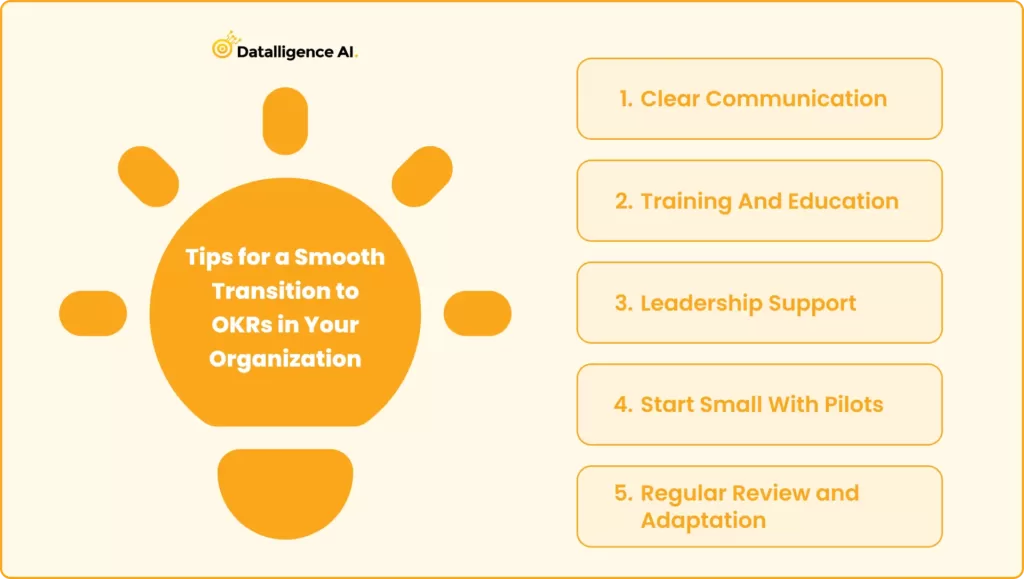
Incorporating Objectives and Key Results (OKRs) into your organization's framework can be transformative, but a seamless transition is essential. Explore these five crucial tips to navigate the journey effectively and unlock the full potential of OKRs.
Clear Communication: Ensure that all employees understand why the company is adopting OKRs, how they work, and how it will benefit both the organization and individual employees.
Training and Education: Provide comprehensive training and workshops to educate employees on OKR principles, best practices, and how to set effective objectives and key results.
Leadership Support: Secure commitment and buy-in from top leadership to champion the transition to OKRs, setting an example for the rest of the organization.
Start Small with Pilots: Consider implementing OKRs initially in a smaller team or department to test the process, gather feedback, and make adjustments before rolling it out company-wide.
Regular Review and Adaptation: Encourage regular check-ins and reviews of OKRs to track progress, make necessary adjustments, and ensure that the goals remain relevant to the organization's evolving needs.
The domain of OKRs is vast, and while there are many tools available, Datalligence unmistakably stands out. Here's why:
Conclusion
The decision to integrate OKRs into an organization’s strategy is pivotal. But, the tools and platforms used to facilitate this change are equally crucial. Datalligence shines in its ability to make the OKR journey smooth, insightful, and effective. As the business environment becomes increasingly competitive, having an edge, like what Datalligence provides, can make all the difference in setting a company on a trajectory of success. Talk to our expert and gain more insights into Try Datalligence today.
Dharma AR2025-08-20T07:21:55+00:00August 19, 2025|General, Objectives and Key Results|
Objective and Key Results (OKRs) have emerged as a
Dharma AR2025-08-20T07:08:48+00:00August 19, 2025|Objectives and Key Results|
An OKR checklist strengthens the goal-setting framework by providing a
Dharma AR2025-07-31T05:21:19+00:00July 30, 2025|Objectives and Key Results|
Sales is the lifeblood of any business. It is the
Dharma AR2025-07-31T05:55:00+00:00July 30, 2025|Objectives and Key Results|
Embarking on the path of personal and professional growth begins
Dharma AR2025-07-30T04:48:12+00:00July 29, 2025|Objectives and Key Results|
Today's business environment is constantly changing, making it challenging for
Dharma AR2025-07-29T05:39:49+00:00July 28, 2025|Objectives and Key Results|
OKRs continue to thrive as one of the most effective
Dharma AR2025-07-24T10:15:20+00:00July 23, 2025|Objectives and Key Results|
Setting attainable, realistic, and attractive goals takes time and work.
Dharma AR2025-07-22T06:52:16+00:00July 21, 2025|Performance Management|
Performance management forms the backbone of any high-performing organization. It
Dharma AR2025-07-18T08:49:19+00:00July 17, 2025|Objectives and Key Results|
In today’s dynamic work culture, 360 degree feedback performance appraisal
Dharma AR2025-07-15T09:10:08+00:00July 14, 2025|Objectives and Key Results|
OKR software helps SaaS startups enhance focus, align teams, and
OKR software helps SaaS startups enhance focus, align teams, and proactively address challenges while tracking and achieving ambitious goals efficiently.
The best OKR software for startups enhances clarity, transparency, and alignment, ensuring individual, team, and organizational goals stay connected.
For SaaS startups, choosing the right OKR management software simplifies goal tracking and streamlines performance alignment for sustained growth.
This article explores top OKR platforms, outlining features and benefits to help startups make informed decisions for effective goal management.
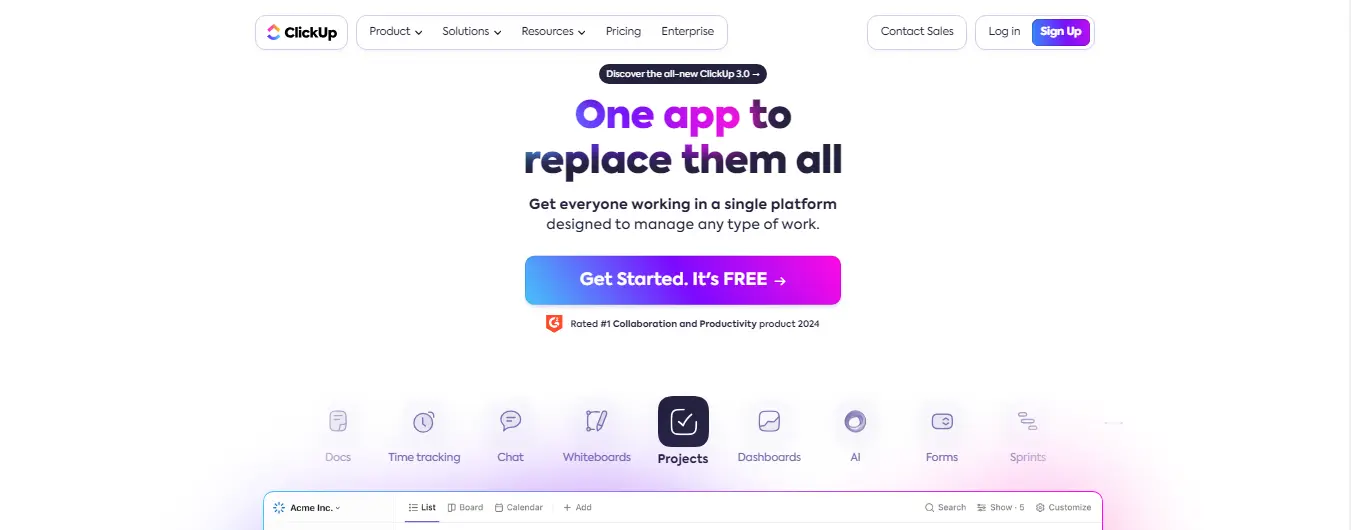
ClickUp is recognized as a comprehensive project management tool that integrates essential OKR (Objectives and Key Results) features, making it a top choice for SaaS startups . This platform is designed to link overarching goals directly with actionable steps, ensuring alignment and accountability across teams.
It offers a robust free version suitable for unlimited users, which includes diverse features like task priorities, multiple views, agile features, customized task statuses, task automations, and integrations with numerous third-party software.
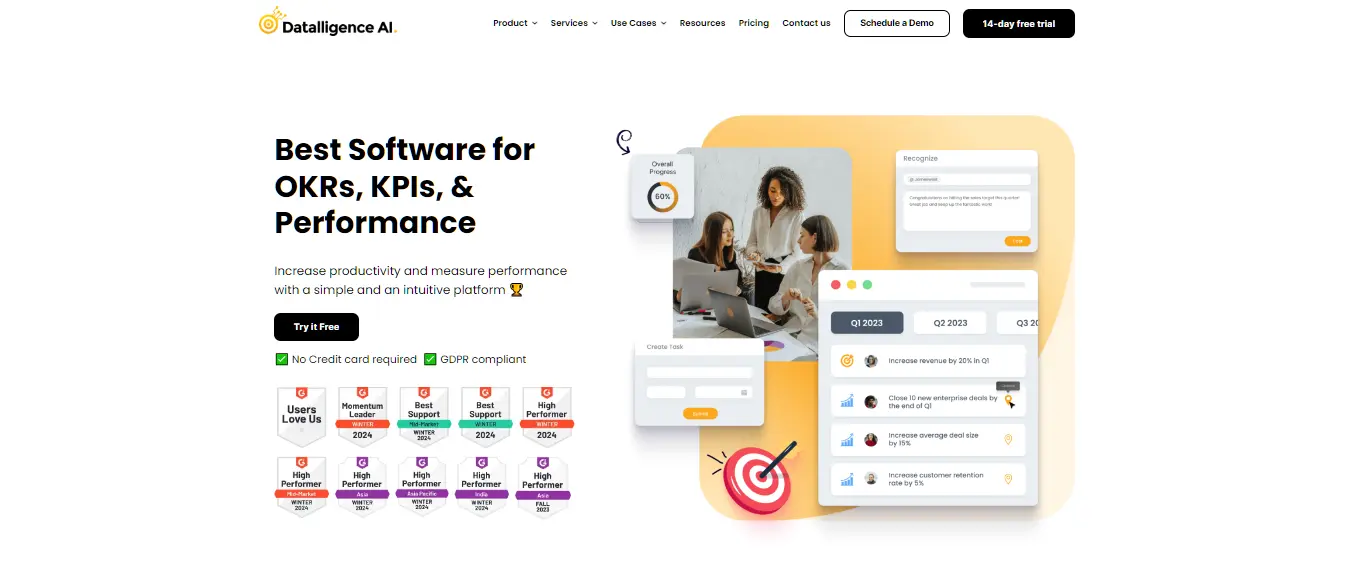
Datalligence serves as an essential OKR (Objectives and Key Results) tool, seamlessly aiding organizations in goal execution. Through its software, the company ensures alignment, tracking, and measurement of Company OKRs, Team OKRs, and Individual OKRs. By integrating Conversation, Feedback & Recognition (CFR), and 180 & 360-degree assessment modules alongside the OKR module, offers a comprehensive approach to addressing business priorities.
Catering to organizations of varying sizes, ranging from startups to established enterprises, the software is accessible through both cloud-based and on-premises versions.
Features of Datalligence
Feedback and Recognition
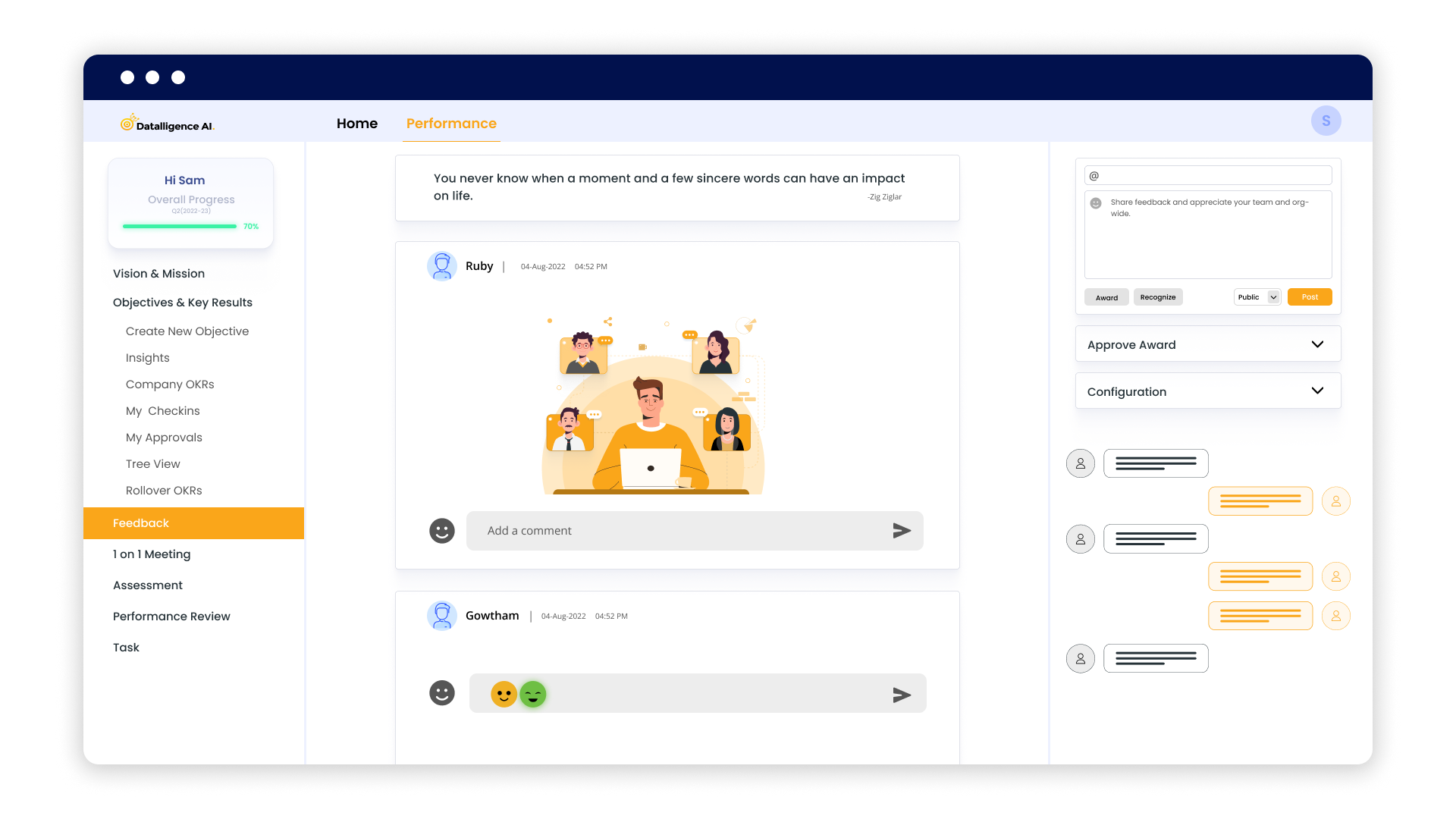
Datalligence promotes a culture of communication and collaboration, connecting teams to discuss and agree on objectives. The open feedback loop and acknowledgment of short wins significantly enhance the goal-setting and achievement process, fostering a supportive work environment.
Real-time Performance Tracking
![]()
The platform offers robust performance tracking features that provide startups with the ability to visualize their goals and measure their performance in real time. Dashboards quickly reveal gaps and issues, allowing for immediate corrective action, which is crucial for maintaining the momentum toward achieving strategic objectives
Real-time Insights and Metrics

Datalligence offers real-time insights and metrics that are crucial for tracking progress toward goals. This feature ensures that SaaS startups can monitor their performance and make necessary adjustments promptly. The tool provides a cloud-based version as well as on-premises deployment, making it adaptable for both startups and established enterprises.
Alignment and Accountability

By integrating features such as goal-setting, check-ins, and feedback, Datalligence ensures strategic alignment across the organization. It aligns team members and stakeholders around common goals, ensuring everyone is accountable for their commitments. This alignment is crucial for startups to maintain focus on strategic priorities and the overall business environment.
Comprehensive Goal Setting and Feedback

Datalligence takes a holistic approach to goal setting by incorporating Conversation, Feedback & Recognition (CFR), and 180 & 360-degree assessment modules. This approach not only helps in setting precise objectives but also in fostering a positive work environment through continuous feedback and recognition. The tool also includes performance tracking and KPI management, which are vital for analyzing and optimizing the output and efficiency of startups
Pros
Cons
Pricing
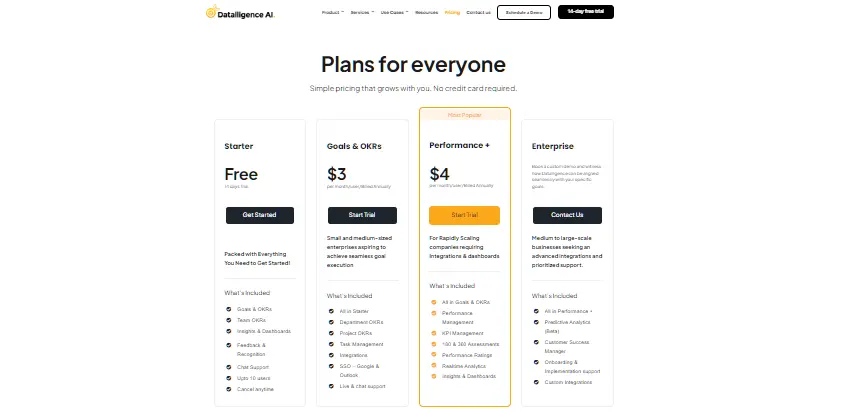
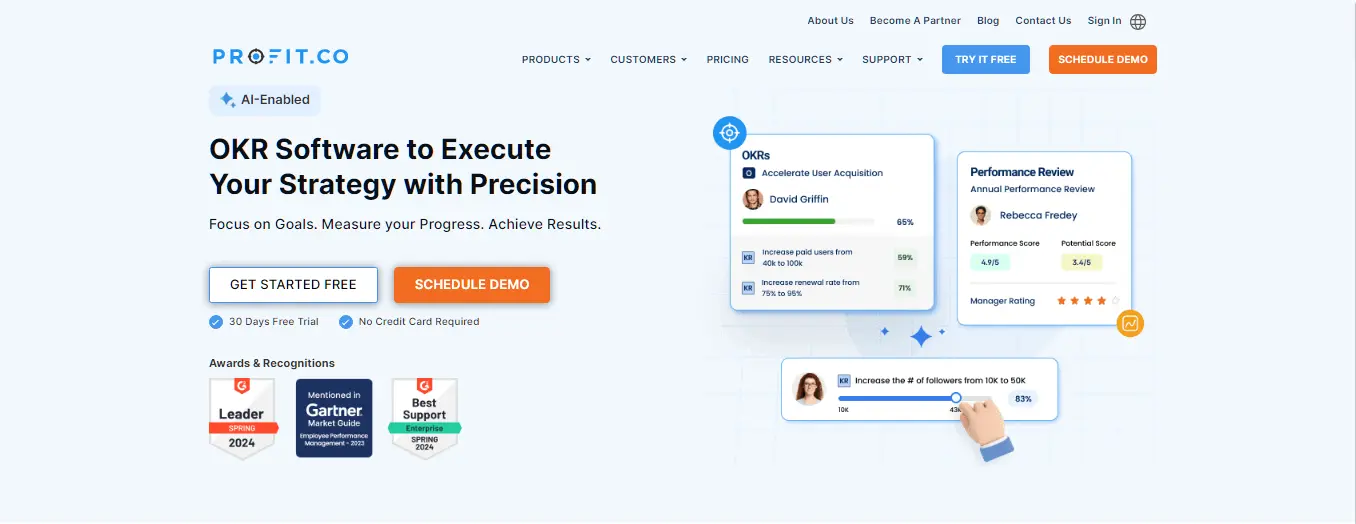
Profit.co stands out as a top OKR software for SaaS startups, offering a comprehensive suite of tools that streamline strategic execution and enhance employee engagement . Its platform is equipped with customizable OKR templates, real-time reports, dashboards, and a unique interconnecting view that aligns priorities, tasks, subtasks, and outcomes effectively . This robust integration helps in maintaining transparency and accountability across all levels of the organization.
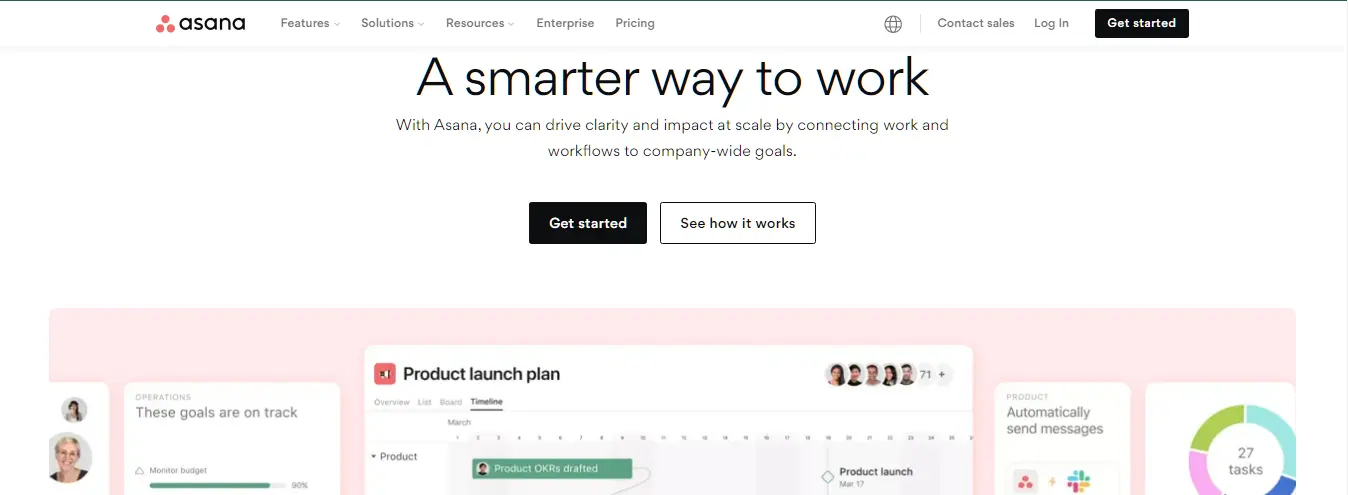
Asana stands out as a versatile platform tailored for SaaS startups, focusing on comprehensive project management and team collaboration . Its array of features encompasses project views, tasks, custom fields, status updates, and advanced reporting, all integrated within a user-friendly interface. This makes it an ideal choice for managing complex projects and aligning team efforts towards common goals .
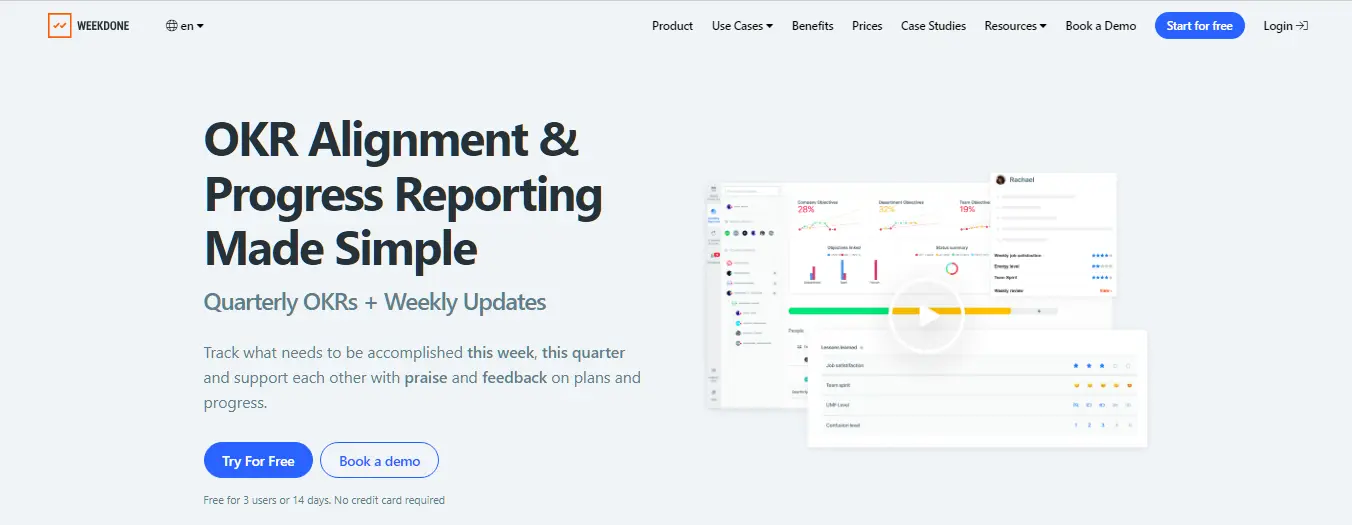
Weekdone is tailored for startups, SMBs, and remote teams, offering a robust OKR software solution . It provides a free version for up to 3 users with complete features, and a 14-day free trial for larger teams, making it accessible for businesses of all sizes.
The platform has been instrumental in helping startups maintain focus on common goals, ensuring team alignment, and adding clarity and transparency across organizations .

Betterworks offers a comprehensive Intelligent Performance Management solution that enhances manager effectiveness and employee engagement through intelligent decision-making tools for HR leaders .
Its goal and OKR software are designed to drive strategic organizational alignment and boost employee performance with flexible, purpose-driven goal-setting methods.
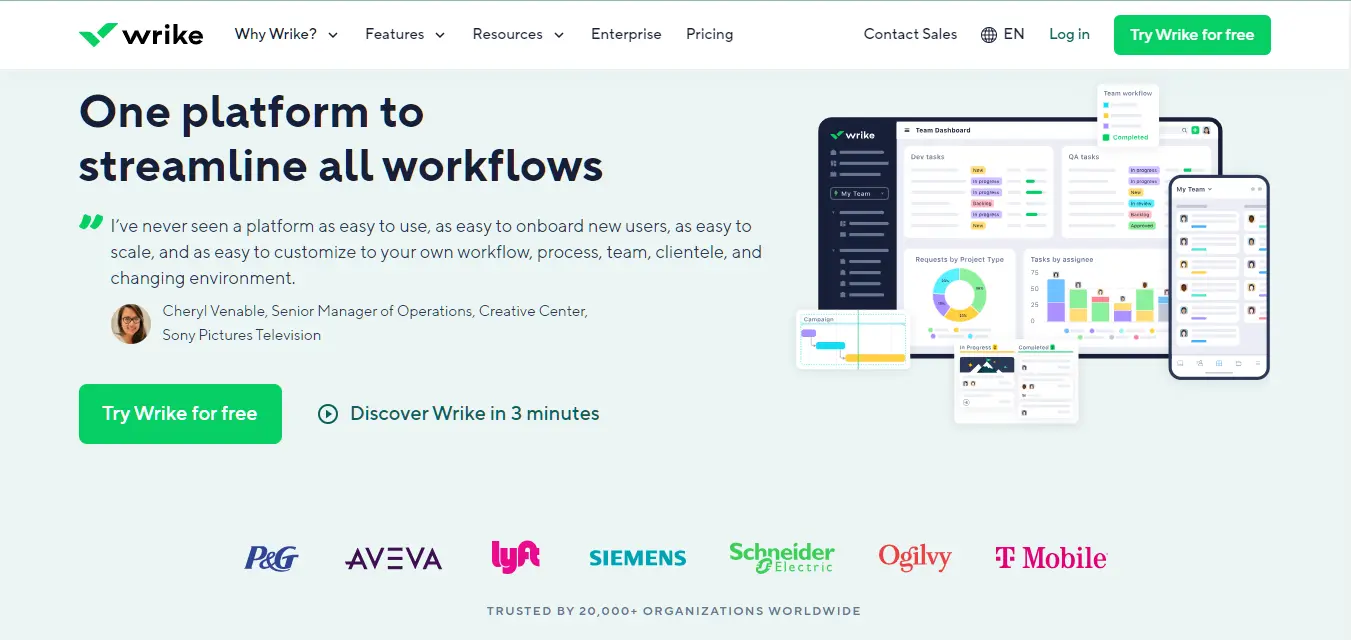
Wrike stands out as a versatile project management tool that integrates robust OKR functionalities to aid SaaS startups in achieving their strategic goals . The platform’s OKR Management & Goal Tracking Software is designed with features that support detailed planning and performance tracking, making it a comprehensive choice for startups looking to streamline their objective-setting processes.

Inspire is a comprehensive Software-as-a-Service (SaaS) platform that integrates various goal-setting methodologies, including OKRs, with performance management and leadership development tools. It offers a suite of applications such as goals or OKRs, feedback mechanisms, one-on-one sessions, recognition programs, learning modules, pulse surveys, and 360-degree feedback, all aimed at enhancing organizational performance

Hirebook is a dynamic OKR tracking tool tailored for startups, focusing on translating strategic goals into actionable results . The platform offers a range of features designed to enhance organizational efficiency and employee engagement.

AchieveIt is a comprehensive OKR and performance management platform designed to streamline strategic planning and execution for organizations, including SaaS startups. The tool is well-regarded for its ability to integrate complex plans into a single, accessible platform, facilitating cross-functional visibility and enhanced execution capabilities.
In the realm of SaaS startups, effective goal management is paramount. Datalligence stands out as the optimal OKR tool, tailored specifically for SaaS companies. With its seamless integration of OKR modules and comprehensive approach to goal setting, Datalligence empowers startups to align, track, and achieve their objectives with clarity and efficiency. Choosing Datalligence ensures streamlined operations, enhanced collaboration, and a solid foundation for long-term success.